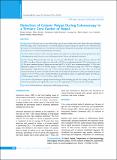Please use this identifier to cite or link to this item:
https://hdl.handle.net/20.500.14356/1160Full metadata record
| DC Field | Value | Language |
|---|---|---|
| dc.contributor.author | Koirala, Dinesh | - |
| dc.contributor.author | Pathak, Rahul | - |
| dc.contributor.author | Bhandari, Brindeswari Kafle | - |
| dc.contributor.author | Jha, Anurag | - |
| dc.contributor.author | Hamal, Rabin | - |
| dc.contributor.author | Gnawali, Arun | - |
| dc.contributor.author | Pandey, Rajesh | - |
| dc.contributor.author | Bhusal, Mohan | - |
| dc.date.accessioned | 2023-04-28T07:52:58Z | - |
| dc.date.available | 2023-04-28T07:52:58Z | - |
| dc.date.issued | 2021 | - |
| dc.identifier.citation | KoiralaD., PathakR., Kafle BhandariB., JhaA., HamalR., GnawaliA., PandeyR., & BhusalM. (2021). Detection of Colonic Polyps During Colonoscopy in a Tertiary Care Center of Nepal. Journal of Nepal Health Research Council, 19(03), 596-602. https://doi.org/10.33314/jnhrc.v19i3.3678 | en_US |
| dc.identifier.issn | Print ISSN: 1727-5482; Online ISSN: 1999-6217 | - |
| dc.identifier.uri | http://103.69.126.140:8080/handle/20.500.14356/1160 | - |
| dc.description | Original Article | en_US |
| dc.description.abstract | Abstract Background: Colorectal cancer is the third leading cause of cancer death in the world. Most colon cancer develop from the polyps. Data on the prevalence of colorectal polyps in Nepal is lacking. The objective was to determine the prevalence of colorectal polyps, site of occurrence and adenomas among various age groups. All polyps after removal by polypectomy was sent for histopathological examination. Methods: Study was done in 1027 consecutive patients who underwent colonoscopy in the pre-specified time after excluding patients with colorectal cancer, Inflammatory Bowel Disease and polyposis syndromes. Results: Among 1027 patients, the mean age was 45 years. 292 (28.43%) were below 40 years, whereas, 735 (71.57%) were above 40 years. Polyps were detected in 12.95% of overall patients and in 9.73% of patients over age 40. The most common location of polyps was rectum (46.62%). 43.61% were adenomatous polyps, 11.28% were hyperplastic polyps, 18.05% were juvenile polyps, 22.56% were inflammatory polyps and 1.50% were malignant adenocarcinoma. Polyp detection rate was 12.95%, whereas adenoma detection rate was 5.84%. 46.55% had advanced adenomas. A positive correlation between the size of polyp and adenomatous variety was found [Chi-square value ?2 = 8.42 (>3.841), p value <0.05]. Prevalence of adenomatous polyps was significantly higher above the age of 40 [Chi-square value ?2 = 11.53 (>3.841), p value<0.05]. Conclusions: The prevalence of polyp increases with age. With increasing age and size of polyp, the prevalence of adenomatous polyp increases significantly. One out of every eight people over 40 years had a colonic polyp. Keywords: Colorectal cancer; colonoscopy; colonic polyp; screening | en_US |
| dc.language.iso | en | en_US |
| dc.publisher | Nepal Health Research Council | en_US |
| dc.relation.ispartofseries | July-Sep, 2021;3678 | - |
| dc.subject | Colorectal cancer | en_US |
| dc.subject | colonoscopy | en_US |
| dc.subject | colonic polyp | en_US |
| dc.subject | screening | en_US |
| dc.title | Detection of Colonic Polyps During Colonoscopy in a Tertiary Care Center of Nepal | en_US |
| dc.type | Journal Article | en_US |
| local.journal.category | Original Article | - |
| Appears in Collections: | Vol. 19 No. 03 (2021): Vol 19 No 3 Issue 52 Jul-Sep 2021 | |
Files in This Item:
| File | Description | Size | Format | |
|---|---|---|---|---|
| 3678-Manuscript-25081-1-10-20211215.pdf | Fulltext Download | 443.5 kB | Adobe PDF |  View/Open |
Items in DSpace are protected by copyright, with all rights reserved, unless otherwise indicated.
